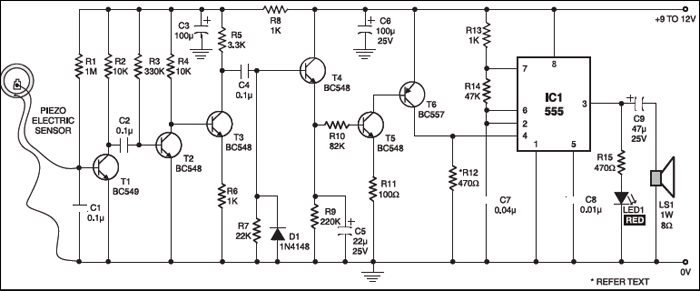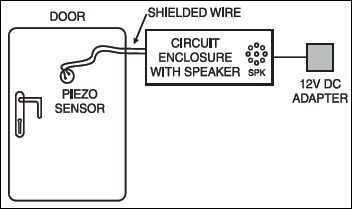 This circuit (Fig. 1), used in conjunction with a thin piezoelectric plate,senses the vibration generated on knocking a surface (such as a door or a table) to activate the alarm. It uses readily-available, low-cost components and can also be used to safeguard motor vehicles. The piezoelectric plate is used as the sensor. It is the same as used in ordinary piezobuzzers and is easily available in the market.
This circuit (Fig. 1), used in conjunction with a thin piezoelectric plate,senses the vibration generated on knocking a surface (such as a door or a table) to activate the alarm. It uses readily-available, low-cost components and can also be used to safeguard motor vehicles. The piezoelectric plate is used as the sensor. It is the same as used in ordinary piezobuzzers and is easily available in the market.

The piezoelectric plate can convert any mechanical vibration into electrical variation. As it doesn’t sense sound from a distance like a microphone, it avoids false triggering. The plate can be fixed on a door, cash box, cupboard, etc using adhesive. A 1-1.5m long, shielded wire is connected between the sensor plate and the input of the circuit. When someone knocks on the door, the piezoelectric sensor generates an electrical signal, which is amplified by transistors T1 through T3.
The amplified signal is rectified and filtered to produce a low-level DC voltage, which is further amplified by the remaining transistors. The final output from the collector of pnp transistor T6 is applied to reset pin 4 of 555 (IC1) that is wired as an astable multivibrator. Whenever the collector of transistor T6 goes high, the astable multivibrator activates to sound an alarm through the speaker. The value of resistor R12 is chosen between 220 and 680 ohms such that IC1 remains inactive in the absence of any perceptible knock.
When the circuit receives an input signal due to knocking, the alarm gets activated for about 10 seconds. This is the time that capacitor C5 connected between the emitter of transistor T4 and ground takes to discharge after a knock. The time delay can be changed by changing the value of capacitor C5. After about 10 seconds, the alarm is automatically reset.
The circuit operates off a 9V or a 12V battery eliminator. The proposed installation of the knock alarm is shown in Fig. 2.









Dear friends, is there a ready made printed circuit board for the “Simple Knock Alarm” ? Kind Regards Christopher Wren
Dear Christopher Wren, as the circuit is quite old. We would be unable to provide you the PCB layout for this circuit.
Yeah sir.. we are having the readymade type of alarm simple knock alarm